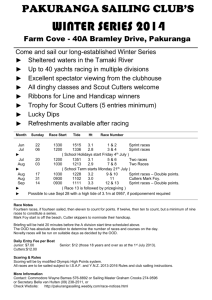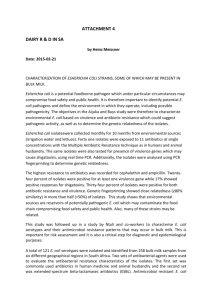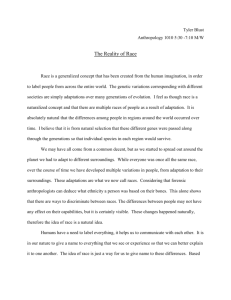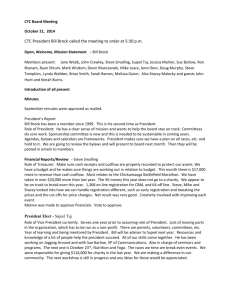Determination of Puccinia helianthi races in the United
advertisement
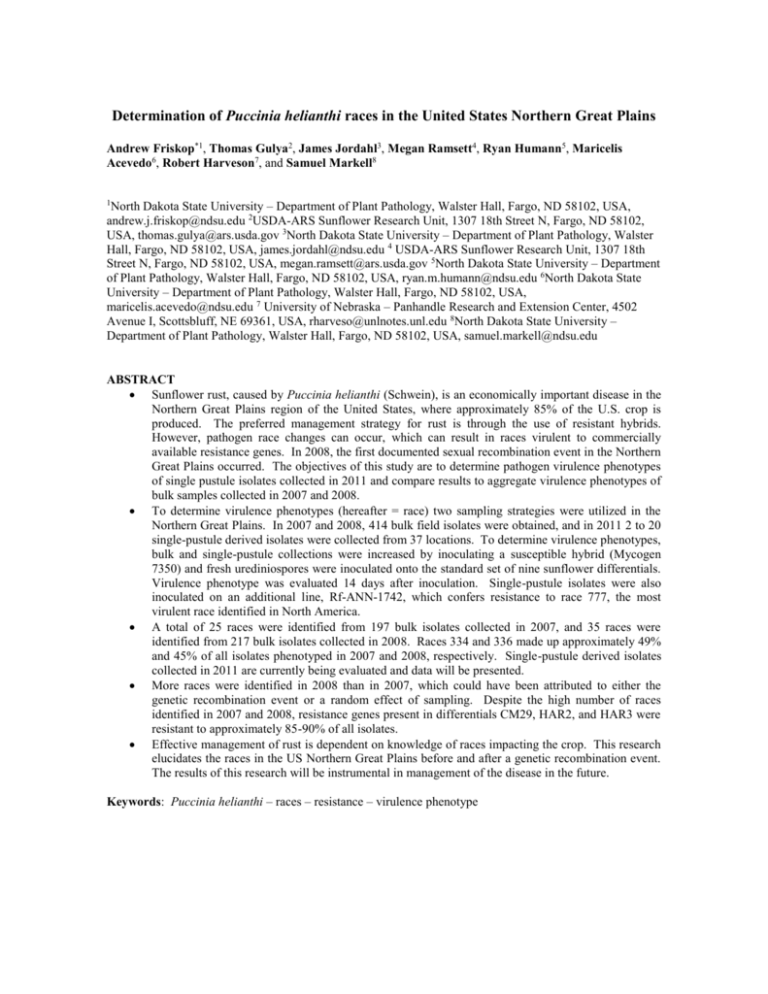
Determination of Puccinia helianthi races in the United States Northern Great Plains Andrew Friskop*1, Thomas Gulya2, James Jordahl3, Megan Ramsett4, Ryan Humann5, Maricelis Acevedo6, Robert Harveson7, and Samuel Markell8 North Dakota State University – Department of Plant Pathology, Walster Hall, Fargo, ND 58102, USA, andrew.j.friskop@ndsu.edu 2USDA-ARS Sunflower Research Unit, 1307 18th Street N, Fargo, ND 58102, USA, thomas.gulya@ars.usda.gov 3North Dakota State University – Department of Plant Pathology, Walster Hall, Fargo, ND 58102, USA, james.jordahl@ndsu.edu 4 USDA-ARS Sunflower Research Unit, 1307 18th Street N, Fargo, ND 58102, USA, megan.ramsett@ars.usda.gov 5North Dakota State University – Department of Plant Pathology, Walster Hall, Fargo, ND 58102, USA, ryan.m.humann@ndsu.edu 6North Dakota State University – Department of Plant Pathology, Walster Hall, Fargo, ND 58102, USA, maricelis.acevedo@ndsu.edu 7 University of Nebraska – Panhandle Research and Extension Center, 4502 Avenue I, Scottsbluff, NE 69361, USA, rharveso@unlnotes.unl.edu 8North Dakota State University – Department of Plant Pathology, Walster Hall, Fargo, ND 58102, USA, samuel.markell@ndsu.edu 1 ABSTRACT Sunflower rust, caused by Puccinia helianthi (Schwein), is an economically important disease in the Northern Great Plains region of the United States, where approximately 85% of the U.S. crop is produced. The preferred management strategy for rust is through the use of resistant hybrids. However, pathogen race changes can occur, which can result in races virulent to commercially available resistance genes. In 2008, the first documented sexual recombination event in the Northern Great Plains occurred. The objectives of this study are to determine pathogen virulence phenotypes of single pustule isolates collected in 2011 and compare results to aggregate virulence phenotypes of bulk samples collected in 2007 and 2008. To determine virulence phenotypes (hereafter = race) two sampling strategies were utilized in the Northern Great Plains. In 2007 and 2008, 414 bulk field isolates were obtained, and in 2011 2 to 20 single-pustule derived isolates were collected from 37 locations. To determine virulence phenotypes, bulk and single-pustule collections were increased by inoculating a susceptible hybrid (Mycogen 7350) and fresh urediniospores were inoculated onto the standard set of nine sunflower differentials. Virulence phenotype was evaluated 14 days after inoculation. Single-pustule isolates were also inoculated on an additional line, Rf-ANN-1742, which confers resistance to race 777, the most virulent race identified in North America. A total of 25 races were identified from 197 bulk isolates collected in 2007, and 35 races were identified from 217 bulk isolates collected in 2008. Races 334 and 336 made up approximately 49% and 45% of all isolates phenotyped in 2007 and 2008, respectively. Single-pustule derived isolates collected in 2011 are currently being evaluated and data will be presented. More races were identified in 2008 than in 2007, which could have been attributed to either the genetic recombination event or a random effect of sampling. Despite the high number of races identified in 2007 and 2008, resistance genes present in differentials CM29, HAR2, and HAR3 were resistant to approximately 85-90% of all isolates. Effective management of rust is dependent on knowledge of races impacting the crop. This research elucidates the races in the US Northern Great Plains before and after a genetic recombination event. The results of this research will be instrumental in management of the disease in the future. Keywords: Puccinia helianthi – races – resistance – virulence phenotype INTRODUCTION Sunflower rust, caused by Puccinia helianthi (Schwein.), is an economically important disease in the Northern Great Plains region of the United States, where approximately 85% of the U.S. crop is produced. Management of the disease is accomplished through the use of resistant hybrids and fungicides, although resistant hybrids are preferred. Pathogen race changes can occur, which can result in races virulent to commercially available resistance genes. In 2008, the first documented sexual recombination event in the Northern Great Plains occurred. This event could lead to the development of new races and may impose a change on race prevalence across the region. Evaluation of pathogen diversity is very important for understanding the risk of sunflower rust epidemics in the future. Previous work on pathogen diversity of bulk field collections was conducted in 2007 and 2008. The bulk virulence phenotype for 392 isolates was evaluated and race characterization was assigned (Gulya and Markell, 2009). Although this information is useful (particularly for breeders) it is insufficient for accurate assessment of true pathogen diversity. Singlepustule (clone) creation is necessary for assessing pathogen diversity using any molecular tools and virulence phenotyping. Kong et al. (1999) and Lawson et al. (2006) used single-pustule isolates to examine virulence phenotypes and molecular diversity in Australia. They found a diverse population and postulated upon the evaluation of races. The limitation of the work was that the scope was Australian in origin. Given that the center of origin of sunflower is North America (likely the pathogen’s center of origin as well), it is possible that the diversity of the pathogen in North America is significantly different from that of Australia. The objectives of this study are to determine pathogen virulence phenotypes of single pustule isolates collected in 2011 and compare results to aggregate virulence phenotypes of bulk samples collected in 2007 and 2008. MATERIALS AND METHODS Two sampling strategies were used to collect sunflower rust. For both sampling techniques, collections were made from both wild and cultivated sunflowers. In 2007 and 2008, a total of 414 bulk field samples were collected from North Dakota, South Dakota, Minnesota, Kansas, Colorado, Iowa, Illinois, and Texas. Samples were collected randomly according to a survey route or sent in from sunflower consultants. Depending on the survey route, rust samples were collected in accordance to the prevalence of sunflowers. Collected (or sent) samples were processed by removing urediniospores from diseased leaves and stored until further use. Urediniospores were increased by inoculating a universal susceptible hybrid - Mycogen 7350. Fresh urediniospores were inoculated on a set of nine differentials (Gulya and Masirevic, 1996) and evaluated 14-days later for reaction types and virulence phenotypes. Once virulence phenotypes were determined, races could be characterized. In 2011, a pre-designed survey route was used to collect between two and 20 singlepustule isolates from 37 ND locations. With some exceptions, stops were made approximately every 32 km. In addition to field derived single pustule isolates, bulk rust samples were obtained from Nebraska and California. The NE and CA samples were single pustuled in the greenhouse in order to obtain clonal isolates. Methods previously described were used for increasing and inoculating urediniospore sources. A total of 108 ND single pustule isolates (2-3 from each location) will be evaluated for virulence phenotype and characterized for race-type. RESULTS AND DISCUSSION The aggregate virulence phenotype of bulk collections (hereafter: bulk race) from 2007 and 2008 were determined. Collections from 2007 yielded 25 bulk races from 197 samples, and 35 bulk races were identified from 217 samples in 2008 (data not presented). Bulk races 336 and 334 were detected 49% and 45% of the time in 2007 and 2008, respectively. The most virulent race (777) was detected twice from both years. More bulk races were identified in 2008 than in 2007, which could have been attributed to either the genetic recombination event or a random effect of sampling. Despite the high number of bulk races identified in 2007 and 2008, resistance genes present in differentials CM29, HAR2, and HAR3 were resistant to approximately 85-90% of all isolates. In 2011, out of 108 single pustule ND isolates, 59 isolates have been processed and 6 races were detected. Two races (races 300 and 304) comprised 85% of tested isolates (Figure 1). Other races detected include 332, 340, 344, and 776. Similarly, CM29, HAR2, and HAR3 conferred resistance to ~90% of the tested isolates. Additionally, 18 ND location sites resulted in the detection of multiple races indicating more than one race may occur in a field at a given time. One study has indicated multiple samples collected within in a field may be an appropriate was to determine virulence diversity of rust pathogens (Jochua et al., 2008). Our study suggests that intensive sampling within fewer fields could be used to make inferences about the pathogen population. Additionally, the frequently identified bulk races identified in 2007 and 2008 conferred virulence on more genes than the majority of races identified with single-pustule isolates. Although the bulk collections were made in different years and locations than the single-pustule isolates, our data implies that mixtures of races may frequently co-exist in fields. Alternately, a bottlenecking of the population can’t be ruled out, but may be unlikely. Additional information on pathogen diversity will be presented once sample processing is complete. Additionally, conclusions may be formulated on the virulence phenotypes of 2011 and will be compared to other out of state isolates, as well as the bulk virulence phenotypes from 2007 and 2008. Figure 1. Number of sunflower rust races detected and prevalence from North Dakota single pustule isolates - 2011 ACKNOWLEDGMENTS The authors would like to thank the National Sunflower Association for their continual support as well as participants of the NSA sponsored survey for sending in samples. REFERENCES Gulya, T. and Markell, S. 2009. Sunflower rust status – 2008 race frequency across the Midwest and resistance among commercial hybrids. In: Proceedings from the 31 st Sunflower Research Workshop. National Sunflower Association. Bismarck, ND. Gulya, T., and Masirevic, S. 1996. Inoculation and evaluation methods for sunflower rust. In: Proc. 18th Sunflower Research Workshop. National Sunflower Association, Bismarck, ND. Jochua, C., Amane, M. I. V., Steadman, J. R., Xue, X., and Eskridge, K. M. 2008. Virulence diversity of the common bean rust pathogen within and among individual bean fields and development of sampling strategies. Plant Dis. 92:401-408. Kong, G. A., Goulter, K. C., Kockman, J. K., and Thompson, S. M. 1999. Evoluation of pathotypes of Puccinia helianthi on sunflower in Australia. Australasian Plant Pathology 28:320-332. Lawson, W., Sendall, B. C. G.A.Kong, K. C. Goulter, E. A. B. Aitken, S. M. Thompson , J. H. M. Mitchell, J. K. Kochman, T. Shatte and T. J. Gulya. 2006. Diversity in the sunflower Puccinia helianthi pathosystem in Australia. Australasian. Plant Plathol. 35:6560670



